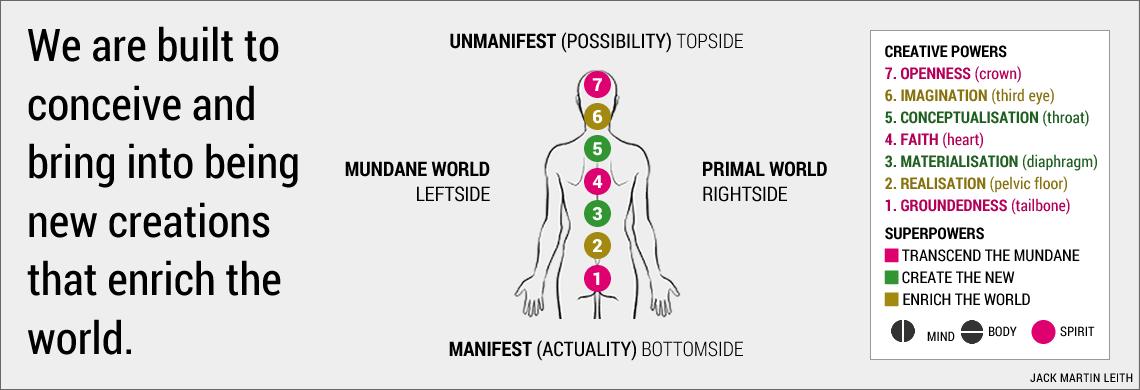
Our species is the only creative species, and it has only one creative instrument, the individual mind and spirit of man. Nothing was ever created by two men. […] Once the miracle of creation has taken place, the group can build and extend it, but the group never invents anything.
John Steinbeck, East of Eden
Caveat
The Newcreator’s creative instrument consists of mind, spirit and a third part that John Steinbeck omitted here: body.
As you work your way through this article, please remember that mind-body-spirit is just a convenient fiction. The same goes for my leftside, rightside, topside and bottomside model. Each one of us is an undivided whole, and the abstracted parts work together in ways we will never fully understand.
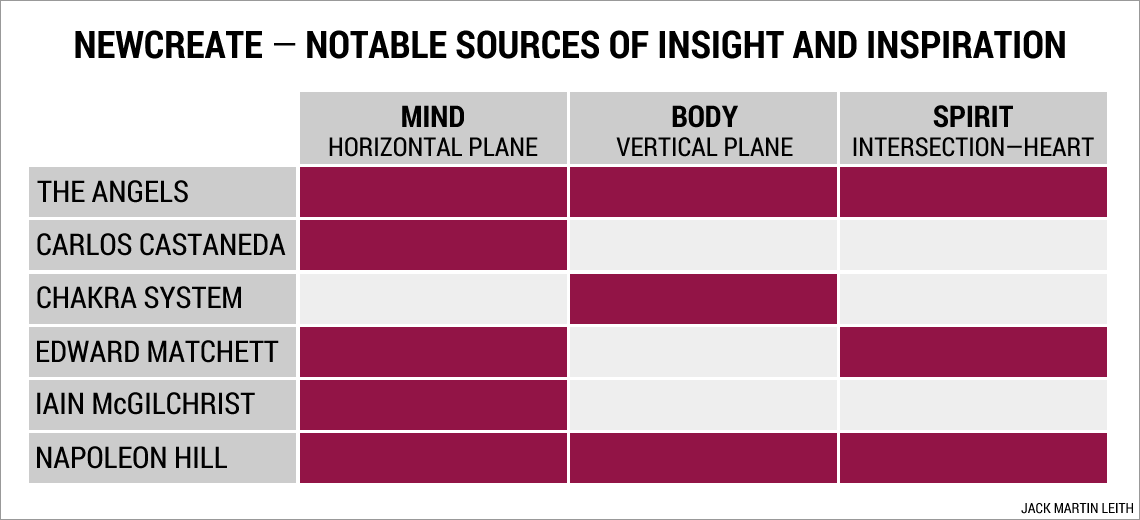
Skip to:
The Newcreator’s mind
Iain McGilchrist: left hemisphere and right hemisphere
Carlos Castaneda: the tonal and the nagual
Napoleon Hill: synthetic imagination and creative imagination
Jack Martin Leith: mundane world and primal world
More leftside / rightside quotes
The Newcreator’s body
The relationship between mind and body
The Newcreator’s spirit
The Newcreator’s Mind

The mind can lean to the left and into mundane world where only synthetic imagination is available, or to the right and into primal world where creative imagination is accessible.
My understanding here is informed by the work of three people in particular (select a name to jump ahead):
Horizontal distinctions compared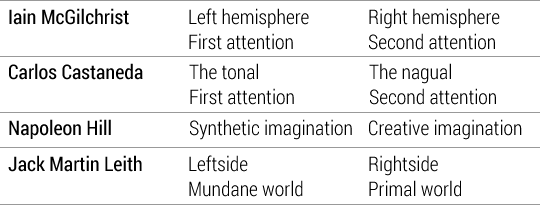
Iain McGilchrist: left hemisphere and right hemisphere
Dr. IaIn McGilchrist is a psychiatrist, philosopher and neuroscience researcher best known for his work on the differences between the left and right hemispheres of the brain and their impact on our perception of and interaction with the world.
He is the author of several books, notably The Master and His Emissary: The Divided Brain and the Making of the Western World, and The Matter with Things: Our Brains, Our Delusions, and the Unmaking of the World.
Find out more about the two books
Jon Evans How do the left and right hemispheres do things differently?
Iain McGilchrist If you want a very simple, single point, it’s that the left hemisphere produces a representation of reality, whereas the right hemisphere actually puts us in touch with the presence of reality. We’re so used to representation that we can’t see how very different it is. Almost everything that we live in now is a representation, a projection on a screen in two dimensions; living in a city which represents certain things but nature is absent from it. So it’s like the difference between a diagram, a theory, a map, and the actual territory of the real world — or the terrain as I prefer to say — in which we live. And the map is very much simpler than the terrain. And that’s not a criticism, because we need simplicity for a map to work. If it had too much information in it, it wouldn’t work. But it’s vital not to mistake the map for the real world.
Jon Evans is host of the YouTube channel Uncensored CMO and chief customer officer at System1 Group
Follow the entire conversation here: The divided brain, attention and how we see the world (video, running time 48:35)

© Michael Leunig
More attributes
- Attention is local, narrow, focused.
- Seeing parts, not wholes.
- Seeing an inanimate world of things.
- Thinking is decontextualized and systematic.
- Closing down to certainty.
- Seeing the world as something like a map, a schema, a diagram, a theory — something two dimensional.
- Helping us manipulate the world.
- Dealing with static things.
- Living in the body, rather as we drive a car.
- Attention is global, broad, vigilant, flexible, sustained.
- Seeing the bigger picture and seeing things whole and in their context.
- Seeing an animate world where things presence to us, rather than being re-presented.
- Opening up to possibility.
- Seeing the world that is being mapped.
- Helping us understand the world.
- Perceiving things in motion and in practice.
- Living the body.
Read more about Iain McGilchrist and his work
Carlos Castaneda: the tonal and the nagual
Carlos Castaneda PhD was an anthropologist. He authored of a series of books (view a list) chronicling his apprenticeship with don Juan Matus.
In Tales of Power, don Juan explains the difference between the tonal (corresponding with left hemisphere, first attention and mundane world) and the nagual, (corresponding with right hemisphere, second attention and primal world).
In the Toltec world of don Juan Matus, the tonal is associated with the right side of the body, and the nagual with the left. As the brain’s left hemisphere controls the right siide of the body and vice versa, the correspondences I have tabulated are correct.
Read more about the tonal and the nagual
Order a copy of Tales of Power from Amazon UK | Download Tales of Power (pdf)
Read more about Carlos Castaneda
Napoleon Hill: synthetic imagination and creative imagination
Napoleon Hill authored the 1937 bestseller Think and Grow Rich!, which is among the best-selling self-help books of all time.
SYNTHETIC IMAGINATION: Through the faculty of synthetic imagination, one may arrange old concepts, ideas, or plans into new combinations1. This faculty creates nothing. It merely works with the material of experience, education, and observation with which it is fed. It is the faculty used most by the inventor, with the exception of he who draws upon the creative imagination, when he cannot solve his problem through synthetic imagination.
CREATIVE IMAGINATION: Through the faculty of creative imagination, the finite mind of man has direct communication with Infinite Intelligence2. It is the faculty through which ‘hunches’ and ‘inspirations’ are received. It is by this faculty that all basic, or new ideas are handed over to man.
Source: Napoleon Hill, Think and Grow Rich!
1. Today, this is known as combinatorial creativity.
2. Read about Infinite Intelligence
Read moreThink and Grow Rich! was written by Napoleon Hill in 1937 and promoted as a personal development and self-improvement book. He claimed to be inspired by a suggestion from business magnate and later-philanthropist Andrew Carnegie. First published during the Great Depression, the book has sold more than 15 million copies. It remains the biggest seller of Napoleon Hill’s books. BusinessWeek magazine’s Best-Seller List ranked it the sixth best-selling paperback business book 70 years after it was published. Think and Grow Rich is listed in John C. Maxwell’s A Lifetime “Must Read” Books List. While the book’s title and much of the writing concerns increasing income, the author insists that his philosophy can help people succeed in any line of work, to do and be anything they can imagine.
Wikipedia — Think and Grow Rich
Think and Grow Rich! — download pdf of entire book
The two forms of imagination: creative and synthetic
Jack Martin Leith: mundane world and primal world
Mundane world corresponds with the left hemisphere, leftside, first attention, the tonal and synthetic imagination.
Primal world corresponds with right hemisphere, rightside, second attention, the nagual and creative imagination.
Iain McGilchrist talks about two worlds but without using qualifiers such as mundane and primal.
There’s a problem here about the nature of the two worlds. They offer us two versions of the world and obviously we combine them in different ways all the time. We need to rely on certain things to manipulate the world but for a broad understanding of it we need to use knowledge that comes from the right hemisphere.
Iain McGilchrist, The Divided Brain and the Making of the Western World — quoted passage begins at timestamp 22:30Running time 32:11
Leftside and mundane world
The left side of the brain controls the right side of the body and vice versa. In order to be consistent with Iain McGilchrist’s hypothesis, leftside and rightside refer to the body as viewed from the rear: your left and right, not stage left and right.
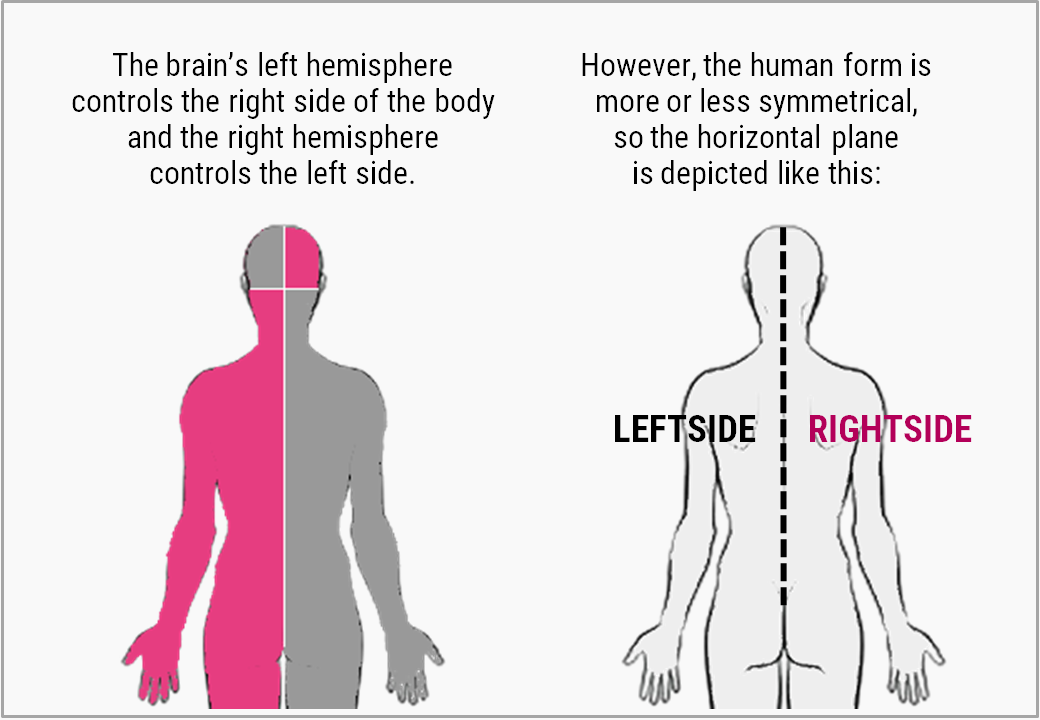
When your mind is left-inclined, you are immersed in mundane world. This is where you spend most of your waking life: in a two-dimensional world of descriptions, experiencing the menu, not the meal. If it can be named, described and explained, it is part of mundane world.
Leftside corresponds with the brain’s left hemisphere as articulated by Iain McGilchrist, and with what don Juan Matus calls the tonal (“toh-na’hl”) and first attention.
Read about the tonal and the nagual
Those who are trapped in mundane world can only access synthetic imagination and not its creative counterpart.
Leftside is both an enabler and a tyrant, enabling you to get things done but making you a slave to reason, demanding the use of synthetic imagination and insisting that creative imagination does not and cannot exist.
In mundane world, possibilities for generative action are hampered by a barrage of rules, norms, codes, beliefs, dogmas, narratives and ideologies.
Design thinking and most other create-the-new approaches (Theory U being a rare exception) overuse leftside and underuse rightside. Newcreators use both sides according to the demands of the particular situation.… it occurred to me that I had become a seer — what is defined as essentially someone who sees things as they are, not as we believe they are, or as we think they are, but the reality behind the reality, the man behind the curtain, the world outside the box.
[That] is when I finally understood that being a seer is really nothing more than being permanently outside the belief systems that otherwise hold the world together. Or, more precisely, the belief systems that create what is commonly called the foreign installation — the predominant series of beliefs and practices that influence, guide and ultimately control human behavior. The end result of being outside the box is that the world and everything in it becomes essentially transparent. That isn’t to say I can tell you the winning lottery numbers or the precise date on which the collapse of civilization as we know it will occur. What it does mean is that it becomes possible to discern shit from shinola, truth from lies, seekers from pretenders, and on down the line.Della Van Hise | View source
Leftside is responsible for reductionism, nominalisation, reification and abstraction. These practices are problematic for people seeking to transcend the mundane, create the new and enrich the world.
Reductionism
Definitions:
- Any theory or method that holds that a complex idea, system, etc, can be completely understood in terms of its simpler parts or components. Source: Collins English Dictionary.
- The process of oversimplifying a complex idea or issue to the point of minimizing or distorting it. Source: Random House Kernerman Webster’s College Dictionary.
When Alfred Korzybski, the originator of general semantics, said “the map is not the territory” he was referring to reductionism’s downside.
The process of modelling is reductionism in action. Like a map, a model omits information — information that could be critical when making decisions or undertaking create-the-new work.
We need simplicity for a map to work. If it had too much information in it, it wouldn’t work. But it’s vital not to mistake the map for the real world.
Iain McGilchrist | Read this passage in context and view its source
Nominalisation
Definitions:
- The process of converting a verb, adverb or adjective into an abstract noun.
- An abstract noun formulated in this way.
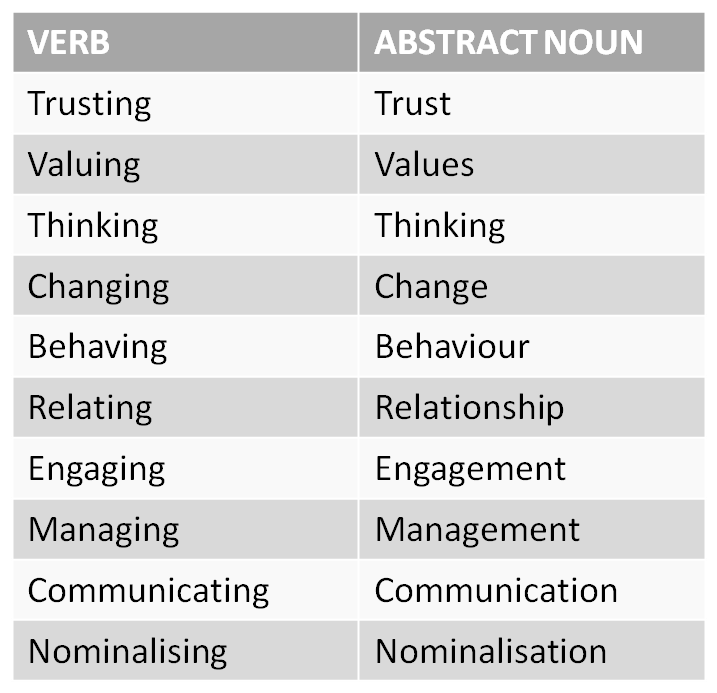
As you can see, nominalisations abound in the organisational world. Note that the term change management consists of an abstraction modified by an abstraction.
Thinking is an interesting example. We talk about creative thinking, strategic thinking, critical thinking and so on, as though these terms represent things with existence in the real world. But here, thinking is working as an abstract noun and not as a verb. Our thinking faculty is not divided into departments, like France or Harrods. If we were to talk instead about thinking creatively, thinking strategically, thinking critically and so forth, our words would resonate more strongly.
Reification
Mistaking an abstract noun for a concrete thing that can be created, acquired, altered, improved, managed or otherwise manipulated is known as reification.
The mathematician and philosopher Alfred North Whitehead called it The Fallacy of Misplaced Concreteness.
In assigning fixed labels we commit the fallacy of misplaced concreteness. According to Whitehead, by mistaking abstractions, beliefs or mental constructs for physical or “concrete” reality, we hypnotise ourselves.
Larry G. Maguire, The Fallacy of Misplaced Concreteness
Abstraction
Definitions:
- The process of formulating generalised ideas or concepts by extracting common qualities from specific examples. Source: Collins English Dictionary.
- An idea or concept formulated in this way. Source: Collins English Dictionary.
Why are nominalisations and abstractions problematic?
- They are simplistic, giving rise to incomplete or faulty understanding (note the nominalisation).
- They are imprecise, leading to miscommunication and ill-informed decision making.
- They engender the illusion of being in control of matters. For instance, many managers believe they can change organisational culture. But the word culture and what it represents is an abstraction and not a real-world thing that can be modified, and certainly not by manipulating values and behaviours, which are themselves abstractions.
- They warp a person’s worldview, resulting in mediocre or deficient create-the-new work and limited downstream value generation.
“A worldview is the set of beliefs about fundamental aspects of reality that ground and influence all one’s perceiving, thinking, knowing and doing.” Source: What is a Worldview? by Ken Funk.
Read more
Abstract nouns are seductive but dangerous, by Valerie Iles
Beware the abstract noun, on the Vernacular website
Wikipedia — Reification (fallacy)
Rightside and primal world
When your mind leans to the right, you experience primal world, a place of pure perception: unfiltered, uncodified and unconceptualised. It is a world you would be very familiar with if raised in the wilderness by wolves. Primal world cannot be described; it can only be experienced.
What does primal mean in this context? Here are some synonyms from the WordHippo website. I have highlighted those that point towards my intended meaning.The nagual is the part of us for which there is no description – no words, no names, no feelings, no knowledge.
Don Juan Matus in conversation with Carlos Castaneda | See The Totality of Oneself: The Tonal and the Nagual

When you are immersed in primal world, you are able to channel intent, the generative impulse that streams from the unmanifest into the manifest through the gap in time, activating creative imagination and infusing your work with purpose, vitality and joy,
Rightside corresponds with the brain’s right hemisphere as described by Iain McGilchrist, and with what don Juan Matus calls the nagual (“nah-wa’hl”) and second attention.
More leftside / rightside quotes
One can say that the nagual accounts for creativity,” [don Juan] finally said and looked at me piercingly. “The nagual is the only part of us that can create.”
He remained quiet, looking at me. I felt he was definitely leading me into an area I had wished he would elucidate further. He had said that the tonal did not create anything, but only witnessed and assessed. I asked how he explained the fact that we construct superb structures and machines.
“That’s not creativity,” he said. “That’s only molding.”
Source: The tonal and the nagual, excerpted from Tales of Power by Carlos Castaneda.
The reality we can put into words is never reality itself.
Werner Heisenberg
As the Toltecs tell us, true creativity does not belong to the tonal. It springs from the incomprehensible nagual.
Tomas, Creative Victory
EGO | Warriors know that there is no ego, there is only the tonal.
EGOMANIA | Warriors know that egomania is an expression of the first attention’s sense of self.
Source: Tomas, from the glossary forming part of Creative Victory, a discourse on the collected works of Carlos Castaneda
What if instead of taming people, we trained them to be more skillful at being wild?
Euvie Ivanova, co-founder of Future Thinkers, on Twitter

TV Sunrise | © Michael Leunig
The first attention3 basically consists of everything that ordinary man considers it means to be human. It is the reality that has been constructed and developed in order to deal with the daily world and encompasses an awareness restricted to the physical body.
Lorraine Voss, Female Warrior (view)
3. First attention corresponds with leftside awareness and mundane world.
We have seen that there are only two parts of your mind. One is ruled by the ego, and is made up of illusions. The other is the home of the Holy Spirit, where truth abides.
Source: A Course in Miracles, Lesson 66 | Download A Course in Miracles in its entirety
In Tales of Power, Castaneda recounted how Matus taught him about the known and the unknown, and about how the known rules our lives even though it’s weak in comparison to our other side, the unknown. Because of its relative weakness, the known must be cunning and ingenious in maintaining the illusion that the unknown doesn’t exist. If the unknown does emerge, the known becomes vulnerable.
Anything more than a brief glimpse of the unknown is deadly for the known and, therefore, for the entire being. When the unknown emerges, it’s like a ‘bad dog’. Repeatedly, Matus dumped buckets of water on Castaneda to “whip his nagual back to its place. The tonal must be protected at any cost. The crown has to be taken away from it, but it must remain as the protected overseer.”
The unknown can only emerge safely if it’s used to boost the known. When this is achieved, it’s called personal power. Without long and careful training any encounter with the unknown results in the known ‘crapping out’, creating a fatal shock. Without training, the known prefers to die rather than give up control.
Peter Luce, Castaneda’s Eight Point Diagram, on Medium
In these passages, the known and the unknown correspond to mundane world and primal world (horizontal plane) respectively, and not to the possible and the actual (vertical plane). Primal world can be known, but only experientially — hence the buckets of water. It cannot be known conceptually.
You have to understand that there are dimensions. In the dimension we call the world4, a person needs logic. He needs it badly. He needs to be able to analyze and take apart things and put them back together again. He needs to spot flaws in reasoning and multiple deceptions. He needs to recognize formal arguments and trace them all the way through from assumptions to conclusions. But in the dimension where creative power operates5, where things happen that most certainly impact this world, all bets are off. He needs to understand and experience and launch a kind of vast freedom for his own imagination that takes him entirely out of the realm of being a normal person, a foolish and provincial “realist,” a mechanically thinking human. He has to go light-years past that. He has to stop pretending he is some kind of scientist. In other words, he has to stop burying his own power. Two dimensions, two capabilities.
Jon Rappoport, The Magician Awakes, cited in The Space, the Magician, and the Man of Science, also by Jon Rappoport
4. This is what I call mundane world.
5. Aka primal world.
We know that some things are key to human flourishing: proximity to nature; a culture; some sense of something beyond this realm. They make people healthier, both physically and mentally. We’ve done away with that and now all we’re left with is public debate.
Left-brain thinking will destroy civilisation | Iain McGilchrist in conversation with Freddie Sayers, Executive Editor of UnHerd, on UnHerd website
‘Reality’ is a ‘doing’, and a doing is measured by its fruits.
Carlos Castaneda, cited in Further Conversations with the Nagual (pdf; 117 pages) by Armando Torres
It is tragic how few people ever “possess their souls” before they die. “Nothing is more rare in any man,” says Emerson, “than an act of his own.” It is quite true. Most people are other people. Their thoughts are someone else’s opinions, their lives a mimicry, their passions a quotation.
Oscar Wilde, De Profundis, cited by Geoff Marlow in his Substack piece Being authentic
It is at the Construct-Aware stage that one becomes aware of ego’s6 narrative function and its cleverness at fooling us into thinking we can know and understand. Few people begin to question the function of ego and our need for myths, stories, and theorizing. Even rarer among ordinary adults, some individuals learn to look kindly at ego’s tireless striving for security and preeminence while seeing through its hopeless efforts.
Construct-Aware folks are the first who potentially realize the illusion of “knowing” and the futility of trying to make ever better maps of reality.
Susanne Cook-Greuter, The Construct-Aware Stage of Ego Development and its Relationship to the Fool Archetype (pdf; 11pp)
6. Here, ego is similar in meaning to the tonal (don Juan Matus), first attention (Iain McGilchrist) and leftside (Jack Martin Leith).
The Newcreator’s Body
Seven creative powers and three superpowers
Newcreators have at their disposal seven creative powers, each associated with a certain part of the body: Openness (location: crown), Imagination (‘third eye’ between the eyebrows), Conceptualisation (throat), Faith (heart), Materialisation (diaphragm), Realisation (pelvic floor) and Groundedness (tailbone).
Realisation refers to the actualisation of the creation’s value generation potential and not to the real world introduction of the creation.
The seven powers combine to form three superpowers: Transcend the Mundane, Enrich the World and Create the New.
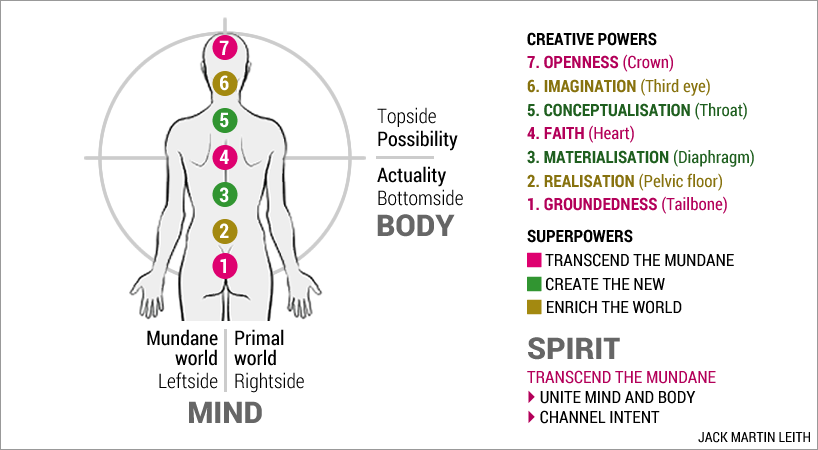
Possibility and actuality
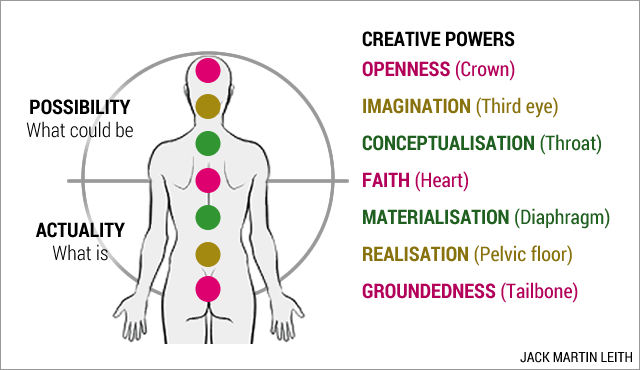
The creative powers of Openness, Imagination and Conceptualisation are associated with the realm of possibility.
The creative powers of Materialisation, Realisation and Groundedness are associated with the realm of actuality.
The creative power of Faith, which binds everything together, is associated with intent and world enrichment.
Actuality is molecular; possibility is atomic7. So actuality is intrinsically different from possibility: it adds something new to possibility. The ontological structure of the actual doesn’t simply recapitulate the ontological structure of the merely possible. Actuality is a different type of reality from possibility.
Colin McGinn, Possibility and Actuality, on his website | Short and profound; highly recommended
7. Colin McGinn seems to be talking about possibilities and not their source — the realm of possibility, a.k.a. the unmanifest, where atoms do not exist because nothing exists, not even realms.
Topside — Possibility
Topside connects us with the source of everything that exists and could exist; the realm (or non-realm, as it has no existence) of infinite possibility; the unknown and unknowable; the eternal.
In the book Talking with Angels it is called the creating world.
It is analogous to what David Bohm calls implicate order.
Bottomside — Actuality
Bottomside connects us to the physical universe and all it contains; the realm of existence and realised possibility; the actual; the known; the temporal.
In the book Talking with Angels it is called the created world.
It is analogous to what David Bohm calls explicate order.
Read more about the seven creative powers and three superpowers
The relationship between mind (horizontal plane) and body (vertical plane)
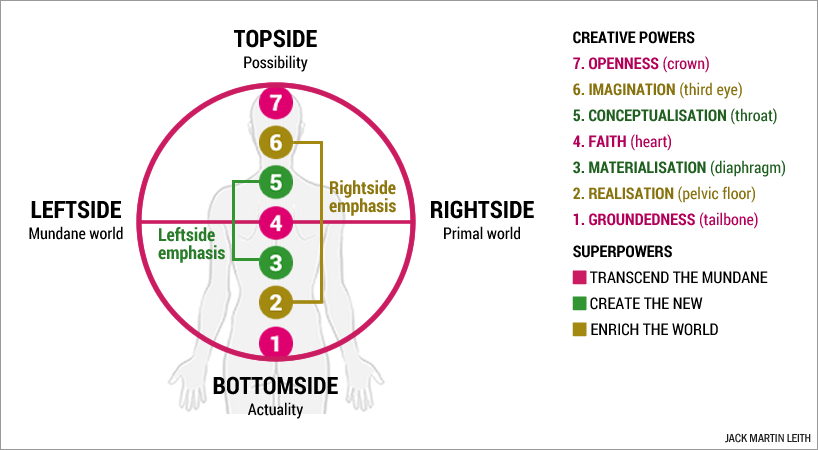
When the Newcreator is doing create-the-new work, the brain’s left hemisphere is in the foreground.
When doing enrich-the-world work, the right hemisphere is to the fore.
However, this is just a difference in emphasis and both hemispheres are active throughout.
The Newcreator’s Spirit
Intent — what many people call spirit — is the generative impulse that streams from the unmanifest into the manifest through the gap in time.
Intent has two aspects. One is the originating aspect, which seeks to initiate new creations. The other is the fulfilling aspect, which seeks to bring new creations to fruition and fully realise their potential.Spirit The animating force throughout creation. An unseen force that is life, the divine, the nagual, the light. To live a spiritual life is to identify oneself as the animator of creation, rather than as creation.
Allan Hardman, The Everything Toltec Wisdom Book
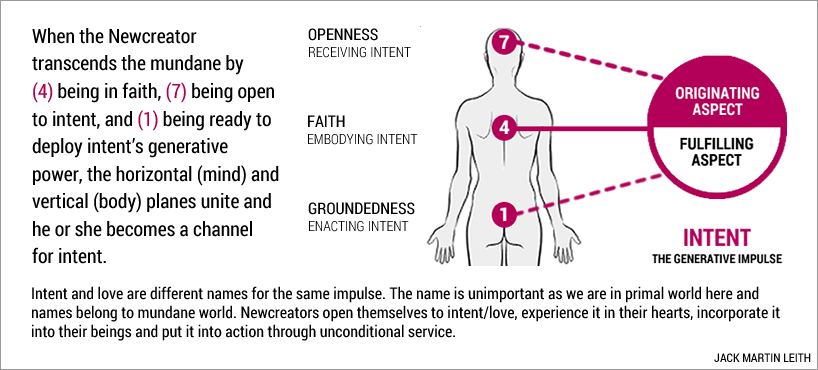 When the Newcreator transcends the mundane by being in faith (4), being open to receive intent (7) and being ready to
When the Newcreator transcends the mundane by being in faith (4), being open to receive intent (7) and being ready todeploy its generative power (1), then the horizontal (mind) and vertical (body) planes unite, the superpowers Create the New and Enrich the World are activated, and he or she becomes a channel for intent.
Although we can’t tell Intent what to do, Toltecs do invoke it and use it. I know that this seems to be a contradiction in terms. But since we are all part of the one universal life, if our purpose is the same as the purpose of the Infinite, then our command becomes the command of the Infinite. When this happens, we can align with Intent and utilize it in creating our life.
Sheri Rosenthal, Intent versus Intention; is there a difference?
The Newcreator is now fully ready to respond to intent’s call and, by means of unconditional service, generate abundant value, meaning and joy. Coming from the heart, unconditional service is unconditional love made manifest through generative action. In essence, intent and (unconditional) love are different words for the same phenomenon.It would be quite good to consider media along the lines of something seeking to manifest through us.
Anthony Blake, Director of Studies at The DuVersity, who collaborated with Edward Matchett and knew him well
Read more
The Energetic Marriage of Love & Intent, by Della Van Hise
Transcend the mundane, create the new and enrich the world
Continue reading
External websites
River Kenna proposes various ways of balancing the hemispheres in this Substack
This website
Iain McGilchrist and his theory of brain hemisphere differences
Seven creative powers and three superpowers
Synthetic imagination and creative imagination
The truly new comes from nothing
Transcend the mundane, create the new and enrich the world
Index to entire site (60+ pages)
Search the site
Just type — not case sensitive — do not hit return